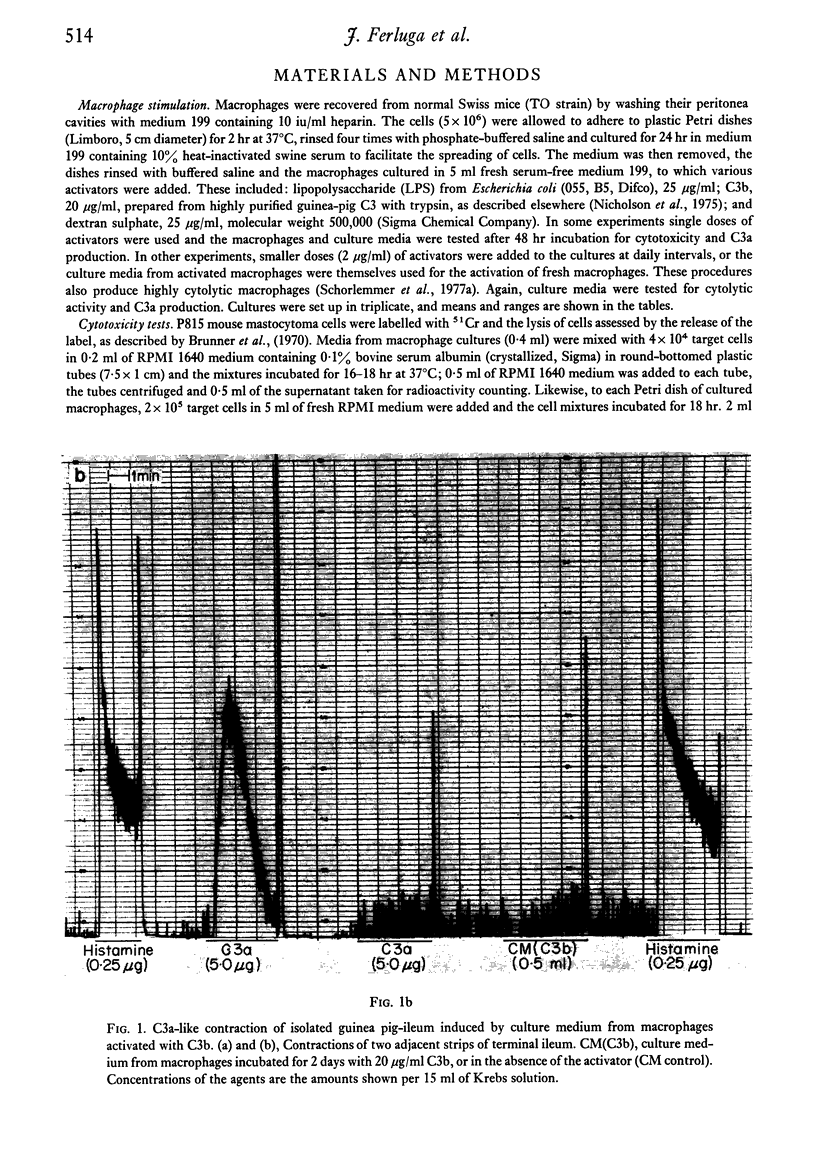Abstract
Mouse peritoneal macrophages were activated in serum-free culture with lipopolysaccharide, dextran sulphate or C3b. They were found to liberate into the culture medium a cytolytic factor and a factor which was pharmacologically indistinguishable from C3a. The cytolytic activity was neutralized by antiserum against C3a. These results suggest that macrophages can be activated by C3b (or agents that generate C3b) to cleave C3, which they themselves produce. In this way the activated macrophages form C3a, which appears to be a major factor in macrophage-mediated cytolysis. These findings have implications in tumour immunity and in the pathogenesis of inflammatory reactions.
Full text
PDF





Images in this article
Selected References
These references are in PubMed. This may not be the complete list of references from this article.
- Bentley C., Bitter-Suermann D., Hadding U., Brade V. In vitro synthesis of factor B of the alternative pathway of complement activation by mouse peritoneal macrophages. Eur J Immunol. 1976 Jun;6(6):393–398. doi: 10.1002/eji.1830060604. [DOI] [PubMed] [Google Scholar]
- Chassoux D., Salomon J. C. Therapeutic effect of intratumoral injection of bcg and other substances in rats and mice. Int J Cancer. 1975 Oct 15;16(4):515–525. doi: 10.1002/ijc.2910160402. [DOI] [PubMed] [Google Scholar]
- Cochrane C. G., Müller-Eberhard H. J. The derivation of two distinct anaphylatoxin activities from the third and fifth components of human complement. J Exp Med. 1968 Feb 1;127(2):371–386. doi: 10.1084/jem.127.2.371. [DOI] [PMC free article] [PubMed] [Google Scholar]
- Currie G. A., Basham C. Activated macrophages release a factor which lyses malignant cells but not normal cells. J Exp Med. 1975 Dec 1;142(6):1600–1605. doi: 10.1084/jem.142.6.1600. [DOI] [PMC free article] [PubMed] [Google Scholar]
- Ferluga J., Schorlemmer H. U., Baptista L. C., Allison A. C. Cytolytic effects of the complement cleavage product, C3a. Br J Cancer. 1976 Dec;34(6):626–634. doi: 10.1038/bjc.1976.223. [DOI] [PMC free article] [PubMed] [Google Scholar]
- Jones J. T., McBride W. H., Weir D. M. The in vitro killing of syngeneic cells by peritoneal cells from adjuvant-stimulated mice. Cell Immunol. 1975 Aug;18(2):375–383. doi: 10.1016/0008-8749(75)90066-0. [DOI] [PubMed] [Google Scholar]
- Kaplan A. M., Morahan P. S., Regelson W. Induction of macrophage-mediated tumor-cell cytotoxicity by pyran copolymer. J Natl Cancer Inst. 1974 Jun;52(6):1919–1923. doi: 10.1093/jnci/52.6.1919. [DOI] [PubMed] [Google Scholar]
- Lai A Fat R. F., van Furth R. In vitro synthesis of some complement components (C1q, C3 and C4) by lymphoid tissues and circulating leucocytes in man. Immunology. 1975 Feb;28(2):359–368. [PMC free article] [PubMed] [Google Scholar]
- Lepow I. H., Willms-Kretschmer K., Patrick R. A., Rosen F. S. Gross and ultrastructural observations on lesions produced by intradermal injection of human C3a in man. Am J Pathol. 1970 Oct;61(1):13–23. [PMC free article] [PubMed] [Google Scholar]
- Meltzer M. S. Tumoricidal responses in vitro of peritoneal macrophages from conventionally housed and germ-free nude mice. Cell Immunol. 1976 Mar 1;22(1):176–181. doi: 10.1016/0008-8749(76)90018-6. [DOI] [PubMed] [Google Scholar]
- Nicholson A., Brade V., Schorlemmer H. U., Burger R., Bitter-Suermann D., Hadding U. Interaction of C3b, B, and D in the alternative pathway of complement activation. J Immunol. 1975 Oct;115(4):1108–1113. [PubMed] [Google Scholar]
- Olivotto M., Bomford R. In vitro inhibition of tumour cell growth and DNA synthesis by peritoneal and lung macrophages from mice injected with Corynebacterium parvum. Int J Cancer. 1974 Apr 15;13(4):478–488. doi: 10.1002/ijc.2910130406. [DOI] [PubMed] [Google Scholar]
- Schorlemmer H. U., Allison A. C. Effects of activated complement components on enzyme secretion by macrophages. Immunology. 1976 Nov;31(5):781–788. [PMC free article] [PubMed] [Google Scholar]
- Schorlemmer H. U., Bitter-Suermann D., Allison A. C. Complement activation by the alternative pathway and macrophage enzyme secretion in the pathogenesis of chronic inflammation. Immunology. 1977 Jun;32(6):929–940. [PMC free article] [PubMed] [Google Scholar]
- Scott M. T. Corynebacterium parvum as a therapeutic antitumor agent in mice. I. Systemic effects from intravenous injection. J Natl Cancer Inst. 1974 Sep;53(3):855–860. doi: 10.1093/jnci/53.3.855. [DOI] [PubMed] [Google Scholar]
- Sethi K. K., Brandis H. Cytotoxicity mediated by soluble macrophage product(s). J Natl Cancer Inst. 1975 Aug;55(2):393–395. [PubMed] [Google Scholar]
- Woodruff M. F., Warner N. L. Effect of Corynebacterium parvum on tumor growth in normal and athymic (nude) mice. J Natl Cancer Inst. 1977 Jan;58(1):111–116. doi: 10.1093/jnci/58.1.11. [DOI] [PubMed] [Google Scholar]




